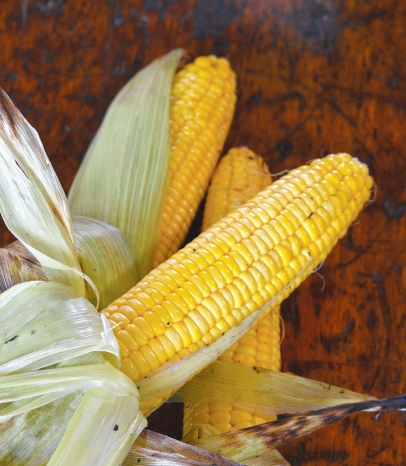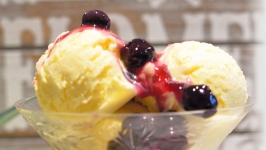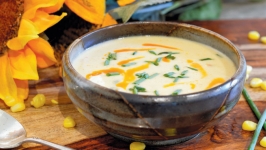Yes, Corn Ice Cream
The United States is kind of corn crazy. We celebrate the golden-colored kernels not only by eating them, but also by naming things after them. There’s the Nebraska Cornhuskers and the not-to-be missed Corn Palace, the South Dakota landmark made completely of corn. And if you are driving through Alabama, don’t miss a stop at the town of Burnt Corn, home to the Civil War’s Battle at Burnt Corn.
Though corn seems as American as apple pie, its origin can actually be traced south of the border. Corn was first cultivated in Mexico over 7,000 years ago, originating from a wild grass called teosinte. From Mexico, corn, also known as maize, spread north into the southwest of the United States. Early uses of corn did not include roasting or boiling the ears. The majority of the kernels were dried and crushed into cornmeal that could be stored and used year-round.
CORN OFF THE COB
Summer is the perfect season to enjoy a juicy bite of roasted corn on the cob. Slathered in butter and perfectly salted, roasted corn and summer barbeques go hand-in-hand.
But this summer, don’t limit your love of corn to just a roasted ear. There’s a world of recipes to use those tender kernels off the cob. Soups make the perfect landing spot for tender corn kernels. But don’t toss out those kernel-naked cobs. Break the shucked and striped corncobs in half and add them to vegetable or chicken stock (homemade or a good quality purchased no-salt-added product) for extra flavor. Strain through a sieve, and your corn stock is ready to be added to your favorite soup recipe.
Keep the soup gluten-free by using Yukon Gold potatoes as the thickening agent. Celery, onions, corn and potatoes are simmered in the strained corn stock then pureed to make a smooth, velvety bisque. For some added kick, add chipotle peppers packed in adobo sauce.
Give the soup a restaurant-quality garnish with a drizzle of chile-infused olive oil. A quick splash is all that’s needed to give your soup some extra flavor and pizazzazz.
SUCCOTASH REVISITED
Succotash, a classic American dish comprised of sweet corn, lima beans, red peppers and okra, is a dish that doesn’t have the best reputation. It could definitely use a makeover.
Swap out the lima beans with green soybeans, called edamame. For extra flavor, try roasted corn kernels, red bell peppers and green onions to create a modern succotash mix. Add your favorite chopped fresh herbs, like basil or mint, a squeeze of fresh lime juice and a drizzle of extra- virgin olive oil to complete this modern twist on an American classic. Although the succotash is delicious on its own, it makes a great resting place for a piece of grilled fish or chicken.
CORN FOR DESSERT
Sweet corn is a classic ice cream flavor in Latin American cultures. A touch of vanilla combined with the sweetness of the corn flavors a traditional ice cream base of whole milk, cream and eggs. It’s time to use those corncobs again. Place the shucked cobs in the cream for the ice cream base. As it simmers on the stove, the corn juice from the cobs will give the base extra corny flavor.
Process the mixture in an ice cream maker, and freeze for several hours before serving. Top off your corn ice cream with a fresh blueberry sauce to create the perfect summertime dessert.
SO YOU WANT TO CUT THE CORN
Story by Terri Milligan
Get the most out of your cob of corn by following a few easy corn kernel removal tips.
START WITH FRESH CORN
The freshest corn is the easiest to work with. Corn straight from the farm stand will still be full of delicious corn juice. Those tender kernels will slide easily from the cob, ready to be added to your favorite corn-off-the cob recipe.
PREP THE COB
Removing the leafy husk and corn silk is an obvious step in proper corn kernel removal. Don’t stop there. Cut the cob of corn in half so you are left with two pieces that each have a flat surface. Place the flat cut side on your work surface so the slender portion of the cob is facing straight up. The flat surface will make it easier to control any unwanted sliding of the cob while cutting.
A STEADY HAND & A SHARP KNIFE
Using a steady hand, start from the top of the cob and slice down in one stroke. Avoid a sawing motion. Cutting too close to the cob will result in tough bits of kernel.
A sharp knife is essential in the kernel-removal process. A chef’s knife works well, but if you are more comfortable using a smaller knife, a sharp paring knife will also do the job. Cut close to the cob, rotating it as you go. Again, avoid cutting too close or you’ll also get the tough bits where the corn is attached to the cob.
KEEP THE JUICE & COBS
Depending on the recipe you are preparing, the sweet juice that comes off the cob when removing the kernels can add extra corn flavor to a dish. Place the cut corn on a baking sheet pan to catch that delicious corn-flavored juice to add to stock or cornbread batter.
Another trick is placing the whole husked corn in the hole of a Bundt or tube pan. In this case, don’t cut the corn in half. Rather, place the smaller end of the corn in the tube pan hole. Use your sharp knife to cut top down on the cob to remove the kernels. The tender corn will fall right into the pan, making kernel roundup easy. No more kernels flying onto your kitchen floor.
Don’t throw out those leftover corncobs. Add the cobs to vegetable stock or use them alone to make corn stock. No time to make stock today? Place some cobs in a freezer bag and store them away for later use.








